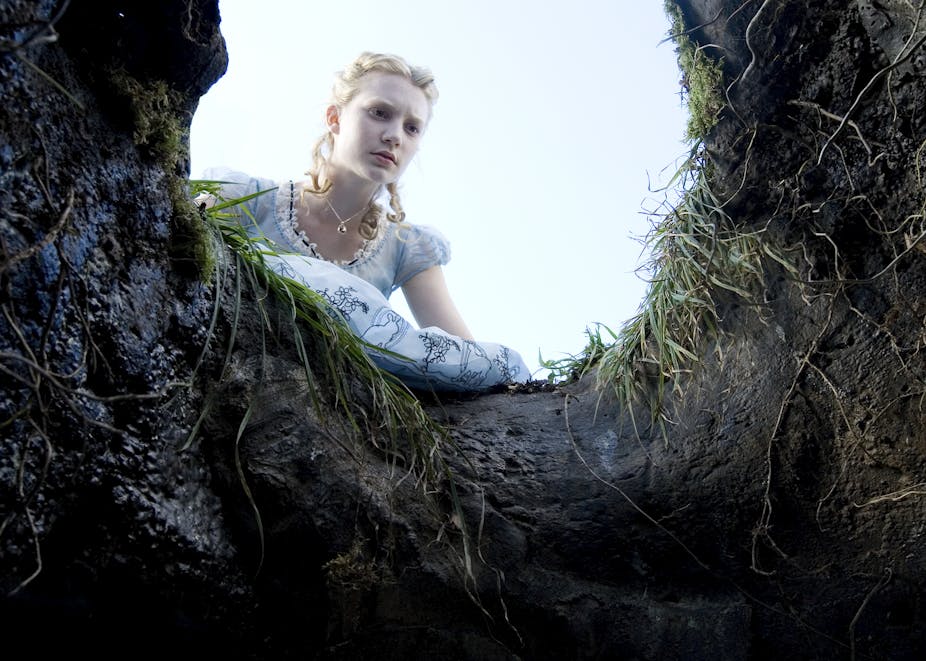The star of Melbourne’s White Night 2015, held last weekend, was Alice. Tributes to her adventures were colourfully projected across buildings along Flinders Street, and formed a fantastical animation on Flinders Station, while the façade of the State Library had a sliding showcase of artistic interpretations of the story, including John Tenniel’s original illustrations.

Entering the rabbit hole (actually, the library doors), a 3-D dreamscape was created on the Dome’s ceiling, set to an electro-pop soundtrack. And the Australian Centre for the Moving Image (ACMI) showed a film adaptation from 1903, a sophisticated production at approximately 12 minutes running time.
Considering “wonderland” is such a key term for describing the White Night experience, it seemed as if Alice in Wonderland was the perfect partner – and this year the partnership was perfectly timed.
2015 is the year we get to celebrate 150 years of Wonderland. It was 1865 that Alice’s adventure was first published for the general public, having started as an oral tale in 1863, told to entertain three young sisters.

Carroll first wrote the story down in 1864, as a keepsake for his child-friend, Alice Liddell. The story was then called Alice’s Adventures Under Ground, and with publication, this was changed to Alice’s Adventures in Wonderland.
150 years later, Wonderland is no longer simply a children’s story. It is films, theatre productions, songs, video games, and theme park rides, and forms the spine of thousands of literary adaptations, printed in more than 170 languages.
I can’t remember the first time I encountered Wonderland, but the story has been with me from a young age, in various incarnations.
Disney’s 1951 film had as strong an impact on me as Carroll’s original story. Looking to my experience, it is likely one which parallels the experiences of other readers and viewers of Wonderland.
Wonderland moved out of copyright in 1907, which means writers and illustrators have had over a century in which to create new versions of the story and characters. It is now a part of our collective memory and cultural history, even for those who have never engaged with the original text.
Adaptations are now such a substantial part of the world of Wonderland that the story stands as one of the most adapted in literature.
The original story, with its fantastical world and characters, lends itself to flexibility. Wonderland has remained popular with readers, and a result from this combination of fantasy and enduring popularity, is that the story has remained a similarly popular choice with adapters from all mediums.

White Night 2015 showed how fixed Wonderland is in popular culture: that the organisers of the event knew enough attendees would feel connected to the story for them to cast Alice in a new leading role. It also showed the brilliant form celebrations of Carroll’s story can take.
The diversity of these tributes testifies to not only the creativity of their creators, but the extraordinary story Lewis Carroll created. What a thrill then to see what will come next.
For those interested in keeping track of global celebrations, two of the largest Lewis Carroll Societies are working alongside Carroll scholars and enthusiasts to track events scheduled throughout 2015. Some 91 events are planned so far, and over 100 publications, not counting the new literary adaptations publishers are planning.
For Melbourne, surely the next major celebration will occur as part of the Emerging Writers’ Festival, in May, and the Melbourne Writers Festival in August, (hint hint).

To calculate the contribution Carroll’s story has made to English literature and popular culture would be a mammoth undertaking, as Wonderland grew roots which moved the story into unexpected places. It can seem almost impossible to believe that this children’s story can be positioned behind only the collected works of Shakespeare and the Bible as the most widely quoted book in the Western world.
One impression the Alice books left on readers however, is to be open to the idea of the impossible:
“I ca’n’t believe that!” said Alice.
“Ca’n’t you?” the Queen said in a pitying tone. “Try again: draw a long breath, and shut your eyes.”
Alice laughed. “There’s no use trying,” she said: “one can’t believe impossible things.”
“I daresay you haven’t had much practice,” said the Queen. “When I was your age, I always did it for half-an-hour a day. Why, sometimes I’ve believed as many as six impossible things before breakfast.”
My current research is on Alice and some of the literary adaptations which make up such a large component of the Alice industry. This year is exciting for me, but for so many others as well. This anniversary provides all of us who love the story, a space to talk, read, see, and marvel at what Wonderland has become.
What Lewis Carroll created deserves to be celebrated. Here’s to Alice!

